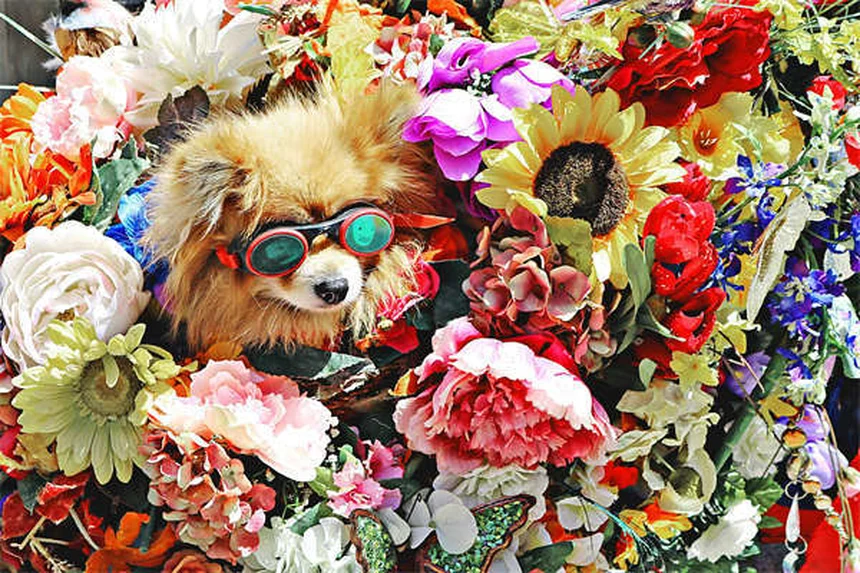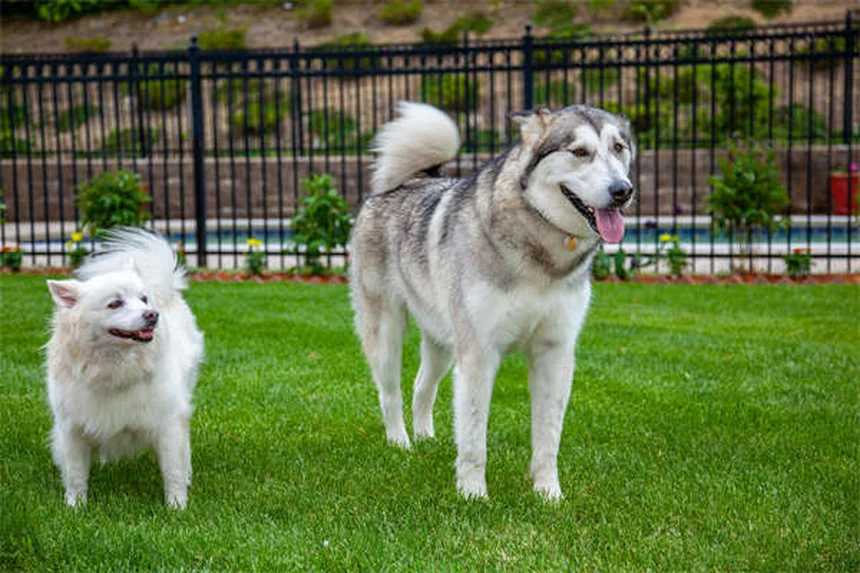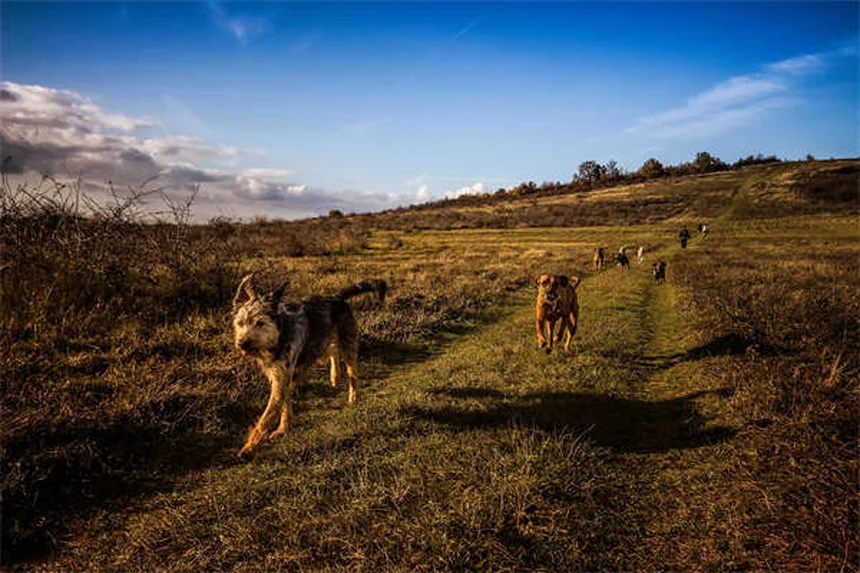Advertisement
What's the best puppy food for your furry bundle of joy? The answer is: puppies need specially formulated food that's different from adult dog food! Your little furball isn't just a small version of an adult dog - they're growing at lightning speed, burning tons of energy, and developing everything from bones to brains. That's why we've put together this complete guide to help you choose the perfect food for your pup's unique needs. I've been through the puppy phase multiple times with my own dogs, and let me tell you - getting their nutrition right from the start makes all the difference. In this article, you'll learn exactly what to look for in quality puppy food, how to transition foods safely, and common mistakes to avoid. Trust me, your future adult dog will thank you!
E.g. :20 Cat Sleeping Positions Explained: What Your Cat's Sleep Habits Reveal
- 1、Meet Your Puppy's Unique Nutritional Needs
- 2、Choosing the Perfect Puppy Food
- 3、Transitioning to New Food Without the Mess
- 4、Puppy Feeding Do's and Don'ts
- 5、Wet vs. Dry Food: The Great Debate
- 6、Special Considerations for Your Growing Pup
- 7、When to Switch to Adult Food
- 8、Common Puppy Feeding Mistakes
- 9、Final Thoughts on Puppy Nutrition
- 10、The Hidden Benefits of Proper Puppy Nutrition
- 11、Beyond Basic Nutrition: Lifestyle Considerations
- 12、The Emotional Side of Feeding
- 13、Future-Proofing Your Puppy's Health
- 14、The Social Aspect of Puppy Feeding
- 15、Seasonal Feeding Considerations
- 16、Tech and Puppy Feeding
- 17、Cultural Differences in Puppy Feeding
- 18、FAQs
Meet Your Puppy's Unique Nutritional Needs
Why Puppies Aren't Just Tiny Adult Dogs
You know what's cuter than a basket of kittens? A puppy doing zoomies around your living room! But here's the thing - that little ball of energy has very different nutritional needs than your adult dog.
Puppies are growing at an incredible rate - their bones, muscles, and even their brains are developing rapidly. That's why they need food packed with high-quality protein, essential fats, and key minerals like calcium and phosphorus. Did you know a puppy's nutritional requirements can be up to twice as high as an adult dog's? Now that's a growth spurt!
The Science Behind Puppy Nutrition
Ever wonder why puppy food looks different from adult dog food? It's not just marketing - there's real science behind it. Puppy formulas contain:
| Nutrient | Puppy Needs | Adult Needs |
|---|---|---|
| Protein | 22-32% | 18-25% |
| Fat | 8-20% | 5-15% |
| Calcium | 1.0-1.8% | 0.5-1.0% |
But here's something you might not know - not all puppy foods are created equal. Some contain special ingredients like DHA (that's docosahexaenoic acid for you science nerds) that supports brain development. Think of it as baby food for your pup's growing mind!
Choosing the Perfect Puppy Food
 Photos provided by pixabay
Photos provided by pixabay
Size Matters - Pick Food for Your Puppy's Future
Here's a fun fact: a Great Dane puppy and a Chihuahua puppy might both be small now, but they'll grow at very different rates. That's why we have special formulas for different sizes:
For large breed puppies (those who'll weigh 55+ lbs as adults), look for food that controls growth rate. Why? Because growing too fast can lead to joint problems later. It's like trying to build a skyscraper too quickly - the foundation needs time to strengthen!
Decoding the Dog Food Label
Ever stared at a dog food bag feeling more confused than your puppy when you say "no"? Let me break it down for you.
The most important thing to look for is the AAFCO statement. This tells you the food meets minimum nutritional requirements. Think of it like a nutrition report card - you want to see "complete and balanced for growth" on there!
Here's a question: Why does AAFCO matter? Great question! AAFCO (the Association of American Feed Control Officials) sets the standards for pet food. Without their approval, you might as well be feeding your pup cardboard - okay, maybe not that bad, but you get the point!
Transitioning to New Food Without the Mess
The Gradual Switch Method
Changing your puppy's food too quickly is like giving a toddler espresso - bad things will happen! Follow this schedule to avoid digestive disasters:
- Days 1-2: 25% new food mixed with 75% old food
- Days 3-4: 50/50 mix
- Days 5-6: 75% new food with 25% old
- Day 7+: 100% new food
Watch for signs of tummy trouble during this time. If your puppy starts looking more like a fountain than a dog, slow down the transition and call your vet.
 Photos provided by pixabay
Photos provided by pixabay
Size Matters - Pick Food for Your Puppy's Future
Here's something many new puppy parents don't realize - you shouldn't switch foods right when you bring your puppy home. That's already a stressful time with new surroundings, smells, and people. Adding a diet change is like starting a new job while moving houses - too much at once!
Wait at least a week after bringing your puppy home before considering a food change. And always consult with your vet first - they're like the puppy nutrition GPS!
Puppy Feeding Do's and Don'ts
Creating Healthy Eating Habits
Did you know that nearly 60% of dogs in the U.S. are overweight? That's right - our love of treats is making our pups pudgy! Here's how to avoid that:
Do: Measure your puppy's food. Eyeballing it leads to overfeeding faster than your puppy can say "more please!" with those puppy dog eyes.
Don't: Free-feed (leaving food out all day). Puppies need scheduled meals - typically 3-4 times daily. It helps with potty training too!
The Treat Trap
Here's a question: How many treats are too many? Treats should make up no more than 10% of your puppy's daily calories. That's about 1-2 small treats per meal for most puppies.
Remember, those puppy eyes are evolutionary weapons designed to break your willpower! Stay strong - your puppy's waistline will thank you later.
Wet vs. Dry Food: The Great Debate
 Photos provided by pixabay
Photos provided by pixabay
Size Matters - Pick Food for Your Puppy's Future
Both wet and dry foods can be great choices, but they have different benefits:
Dry food: Helps clean teeth, is more calorie-dense, and usually costs less. It's like the jeans-and-t-shirt of dog food - practical and reliable.
Wet food: More palatable for picky eaters, higher water content, and often more expensive. Think of it as the fancy dinner out option!
Mixing It Up
You can absolutely mix wet and dry food - many owners do this to provide variety. Just remember to adjust portions accordingly. It's like mixing cereal and milk - both good separately, but together they're magic!
The key is finding what works for your puppy's taste buds and your lifestyle. Some puppies go nuts for kibble, while others turn their noses up at anything that isn't served with a silver spoon!
Special Considerations for Your Growing Pup
Large Breed Specific Needs
If you've got a future giant on your hands, pay extra attention to their food. Large breed puppies need:
- Controlled calcium levels (1.0-1.5%)
- Moderate fat content (12-16%)
- Glucosamine for joint health
These special formulations help prevent developmental orthopedic diseases. It's like giving your puppy's skeleton the best possible building materials!
Small Breed Solutions
Tiny dogs have tiny mouths and even tinier stomachs! Look for:
Smaller kibble size (so they don't choke), higher calorie density (they burn energy fast), and more frequent meals. It's the espresso version of puppy food - small but mighty!
When to Switch to Adult Food
Reading the Signs
Most puppies transition to adult food between 9-24 months, depending on size. But how do you know when it's time?
Look for these signs: your puppy's growth has slowed significantly, they're approaching their expected adult weight, and they're less interested in their puppy food. It's like when a teenager stops growing out of shoes every month!
The Gradual Transition (Again!)
Remember that transition schedule we talked about earlier? You'll want to use it again when switching to adult food. Slow and steady wins the race - and prevents tummy troubles!
Always consult your vet about the right time to make the switch. They can help you determine if your puppy is physically ready for adult food.
Common Puppy Feeding Mistakes
Overfeeding: The Biggest Offender
Those puppy eyes are powerful, but resist the urge to overfeed! An overweight puppy is at risk for:
- Joint problems
- Diabetes
- Heart disease
Follow the feeding guidelines on your puppy food bag, but remember - these are just starting points. Your vet can help you adjust based on your puppy's individual needs.
Human Food Hazards
While it's tempting to share your dinner, many human foods are dangerous for puppies. Avoid:
Chocolate, grapes, onions, garlic, and xylitol (found in sugar-free products). When in doubt, stick to puppy-approved treats. Your pup will love you just as much for a carrot stick as for that piece of bacon!
Final Thoughts on Puppy Nutrition
Trust the Process
Feeding your puppy properly might seem complicated at first, but you'll get the hang of it. Before you know it, you'll be a puppy nutrition pro - reading labels like a detective and measuring food like a chemist!
The most important thing? Love your puppy, feed them well, and enjoy every moment of this special time. They grow up so fast - both literally and figuratively!
When in Doubt, Ask the Experts
Your veterinarian is your best resource for puppy nutrition questions. Don't be shy about asking - they've heard it all before, from "Can my puppy eat grass?" to "Is it normal that my puppy eats his own poop?" (The answers: yes, and unfortunately, also yes.)
With the right food and care, your puppy will grow into a healthy, happy adult dog. And that's what we all want - many years of tail wags and sloppy kisses ahead!
The Hidden Benefits of Proper Puppy Nutrition
Brain Development Beyond the Bowl
Did you know that what your puppy eats today could affect their ability to learn commands tomorrow? Omega-3 fatty acids, especially DHA, play a crucial role in cognitive development. We're talking about the difference between a dog that masters "sit" in three tries versus one that still looks confused after thirty attempts!
Studies show puppies fed diets rich in DHA perform better in problem-solving tests. Imagine your pup as a little furry student - you want to give them the best "brain food" possible! Some premium puppy foods even include ingredients like blueberries and turmeric for additional cognitive benefits. Who knew your puppy's kibble could be so sophisticated?
The Gut-Brain Connection
Here's something fascinating - your puppy's gut health affects their mood and behavior. A balanced microbiome (that's the good bacteria in their digestive system) can mean fewer anxiety issues and better stress management. Ever notice how some puppies seem calmer than others? Nutrition might be part of the reason!
Probiotics and prebiotics in quality puppy foods support this gut health. It's like giving your pup a tiny internal spa treatment with every meal. And let's be honest - a happy gut means fewer "accidents" on your new carpet!
Beyond Basic Nutrition: Lifestyle Considerations
Active Puppies Need Special Fuel
If you've got a future agility champion or hiking buddy, their nutritional needs differ from couch potato pups. High-energy puppies burn calories faster than you can say "fetch!" They need:
- Higher protein content (30% or more)
- Increased fat for sustained energy
- Electrolytes to replace what they lose through panting
Think of it like fueling a sports car versus a sedan - both need gas, but the performance vehicle requires premium! Just remember - too much exercise before their growth plates close can be harmful, so balance activity with rest.
City Puppies vs. Country Puppies
Believe it or not, your environment affects your puppy's nutritional needs. City pups exposed to more pollutants might benefit from additional antioxidants. Country pups running through fields might need extra tick and flea protection in their diet. It's like tailoring their food armor to their specific battleground!
Urban dogs also tend to walk on hard surfaces that can be tough on developing joints, making glucosamine supplements particularly valuable. Meanwhile, rural pups might encounter more varied terrain that builds muscle differently. Who knew geography could influence what's in your dog's bowl?
The Emotional Side of Feeding
Bonding Over Meals
Feeding time isn't just about nutrition - it's prime bonding opportunity! The way you interact during meals can strengthen your relationship. Try hand-feeding some kibble as rewards during training sessions. It's like having dinner and a show, with your puppy as the star performer!
Ever notice how your puppy looks at you while eating? That's trust developing bite by bite. Creating positive associations with mealtime sets the stage for a lifetime of happy feeding experiences. Just try not to melt when those puppy eyes lock onto yours!
The Psychology of Picky Eaters
Some puppies turn their noses up at food like tiny gourmet critics. But is this really about taste, or something deeper? Often, picky eating stems from:
- Stress in new environments
- Overfeeding with treats
- Lack of routine
Establishing consistent feeding times and resisting the urge to offer endless alternatives can help. Remember - a healthy puppy won't starve themselves! Though they might act like they're wasting away after missing one snack...
Future-Proofing Your Puppy's Health
Preventing Allergies Before They Start
Did you know that early exposure to varied protein sources might reduce allergy risks later? While traditional wisdom said to stick to one protein, new research suggests introducing different meats (chicken, beef, fish) in controlled ways could build tolerance. It's like vaccinating against food allergies!
Of course, always introduce new proteins gradually and watch for reactions. The goal isn't to overwhelm their system, but to carefully expand their culinary horizons. Your puppy might discover they're a seafood lover at heart!
Dental Health Starts Now
Those tiny puppy teeth will be replaced by adult chompers, but good dental habits begin early. Certain kibble shapes and textures help clean teeth as your pup chews - nature's toothbrush! You can also introduce puppy-safe dental treats early to get them comfortable with oral care.
Imagine saving thousands on vet dental cleanings because you started prevention during puppyhood! Plus, nobody wants doggy breath kisses - except maybe other dogs, but we're trying to impress humans here.
The Social Aspect of Puppy Feeding
Multi-Pet Household Dynamics
If you have other pets, mealtime becomes a delicate dance. Puppies shouldn't eat adult dog food, and cats certainly shouldn't eat dog food at all (despite what they might think!). Creating separate feeding zones prevents food theft and reduces stress.
Watch for resource guarding behaviors early - some puppies get possessive about food. Positive reinforcement can teach them that mealtime is peaceful. Because nothing ruins dinner like a cat-dog food standoff!
Puppy Playdates and Treat Etiquette
When your puppy's friends come over, everyone wants to share treats. But not all puppies can handle the same foods! Keep safe, bland treats on hand for guest pups, and always ask owners about dietary restrictions first. It's like being the considerate host who remembers everyone's food allergies!
Also, monitor treat distribution to prevent bullying or gorging. You don't want one pup hoarding all the goodies while others watch sadly. That's just rude in any species!
Seasonal Feeding Considerations
Summer Survival Strategies
Hot weather affects puppies more than adults. They might need:
- More frequent water breaks
- Smaller, cooler meals
- Electrolyte supplements if very active
Ever seen a puppy panting like they just ran a marathon after a short walk? That's your cue to adjust their routine! Frozen treats (like kibble in ice cubes) can help them cool down while staying hydrated.
Winter Warm-Up Foods
Cold months might call for slight calorie increases, especially for short-haired breeds. Warming foods like slightly heated wet food or bone broth can be comforting. Just think - your puppy's version of hot cocoa on a snowy day!
Of course, indoor pups with central heating might not need many adjustments. The key is observing your individual puppy's needs rather than following blanket rules. Because let's face it - some dogs would wear sweaters in July if we let them!
Tech and Puppy Feeding
Smart Feeders for Busy Puppy Parents
Automatic feeders aren't just for when you're away - they can help with:
- Portion control
- Scheduled small meals
- Monitoring how much your puppy eats
Some even sync with apps to track eating patterns! Though nothing replaces your presence, these gadgets can be lifesavers during busy days. Just don't be surprised if your puppy starts trying to "hack" the feeder for extra meals!
The Rise of Fresh Food Delivery
Subscription services now deliver fresh, human-grade meals tailored to your puppy's needs. While pricier than kibble, these options offer restaurant-quality dining for discerning pups. It's like meal prepping for your dog, minus the Sunday afternoon cooking marathon!
These services often include veterinary nutritionist-designed recipes with precise portions. Your puppy might start expecting candlelit dinners next!
Cultural Differences in Puppy Feeding
Global Puppy Cuisine
Around the world, puppy feeding practices vary fascinatingly:
| Country | Common Puppy Diet | Unique Aspect |
|---|---|---|
| Japan | Fish-based foods | Often includes seaweed |
| Italy | Pasta scraps | Mixed with lean meats |
| Australia | Kangaroo meat | Novel protein source |
While we don't recommend suddenly switching your puppy to international cuisine without research, it's interesting to see how culture shapes pet nutrition. Who knew some puppies down under were eating like actual kangaroos?
Raw Feeding Debate
The raw food movement has passionate advocates and critics. Proponents claim benefits like shinier coats and cleaner teeth, while veterinarians often warn about bacterial risks. It's the puppy nutrition version of "Pineapple on pizza" - everyone has strong opinions!
If considering raw, consult a veterinary nutritionist to ensure balanced meals. Because while wolves eat raw in nature, they also don't live as long as our domestic dogs - and we definitely want many years with our pups!
E.g. :Puppy Feeding Fundamentals: Timeline for Puppy Feeding
FAQs
Q: How is puppy food different from adult dog food?
A: Puppy food is specially formulated with higher levels of protein, fat, and essential nutrients to support rapid growth and development. While adult dogs might do fine with 18-25% protein, puppies typically need 22-32% protein in their diet. The difference is like comparing baby food to adult meals - both nutritious, but designed for different life stages. Puppy foods also contain more calcium and phosphorus for bone development, and often include DHA for brain development.
Another key difference? Puppy food has more calories per cup because those little zoomie machines burn energy like crazy! But don't worry - we'll help you figure out exactly how much to feed so your pup grows at a healthy rate without packing on extra pounds.
Q: When should I switch from puppy to adult food?
A: The right time to switch depends on your dog's breed size. Small breeds (under 20 lbs) can usually transition around 9-12 months, while large and giant breeds (55+ lbs) should stay on puppy food until 18-24 months. Here's why: large breed puppies need controlled growth to prevent joint problems.
Watch for these signs that your puppy is ready for adult food: their growth has noticeably slowed, they're approaching their expected adult weight, and they seem less interested in meals. And remember - always make the switch gradually over 7-10 days to avoid tummy troubles!
Q: Can I feed my puppy wet and dry food together?
A: Absolutely! Mixing wet and dry puppy food can be a great way to provide variety and make meals more exciting. Many pet parents find that adding a spoonful of wet food to kibble helps picky eaters clean their bowls. Just be sure to adjust portion sizes accordingly so you're not overfeeding.
One pro tip from my experience: if you're using wet food as a topper, try warming it slightly to release more aroma. Puppies eat with their noses first! Just be sure any wet food you choose is specifically formulated for puppies to ensure complete nutrition.
Q: How often should I feed my puppy?
A: Puppies need frequent, scheduled meals - typically 3-4 times per day until about 6 months old. Here's a sample schedule that's worked well for my pups: breakfast at 7 AM, lunch at 12 PM, dinner at 5 PM, and a small bedtime snack at 10 PM.
As your puppy grows, you can gradually reduce to 2-3 meals daily. The key is consistency - feeding at the same times each day helps with potty training and prevents blood sugar drops. And please, resist those puppy eyes begging for extra snacks between meals!
Q: What should I look for on puppy food labels?
A: First and foremost, check for the AAFCO statement confirming the food is "complete and balanced for growth." This is your guarantee the food meets minimum nutritional standards. Next, look at the ingredients list - high-quality protein sources (like chicken or lamb) should be first.
For large breed puppies, specifically look for controlled calcium levels (1.0-1.5%) and added joint supplements. And don't forget the "best by" date - fresh food means better nutrition! When in doubt, your vet can help decode labels and recommend brands that fit your puppy's needs.


















